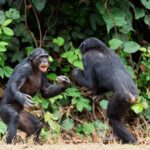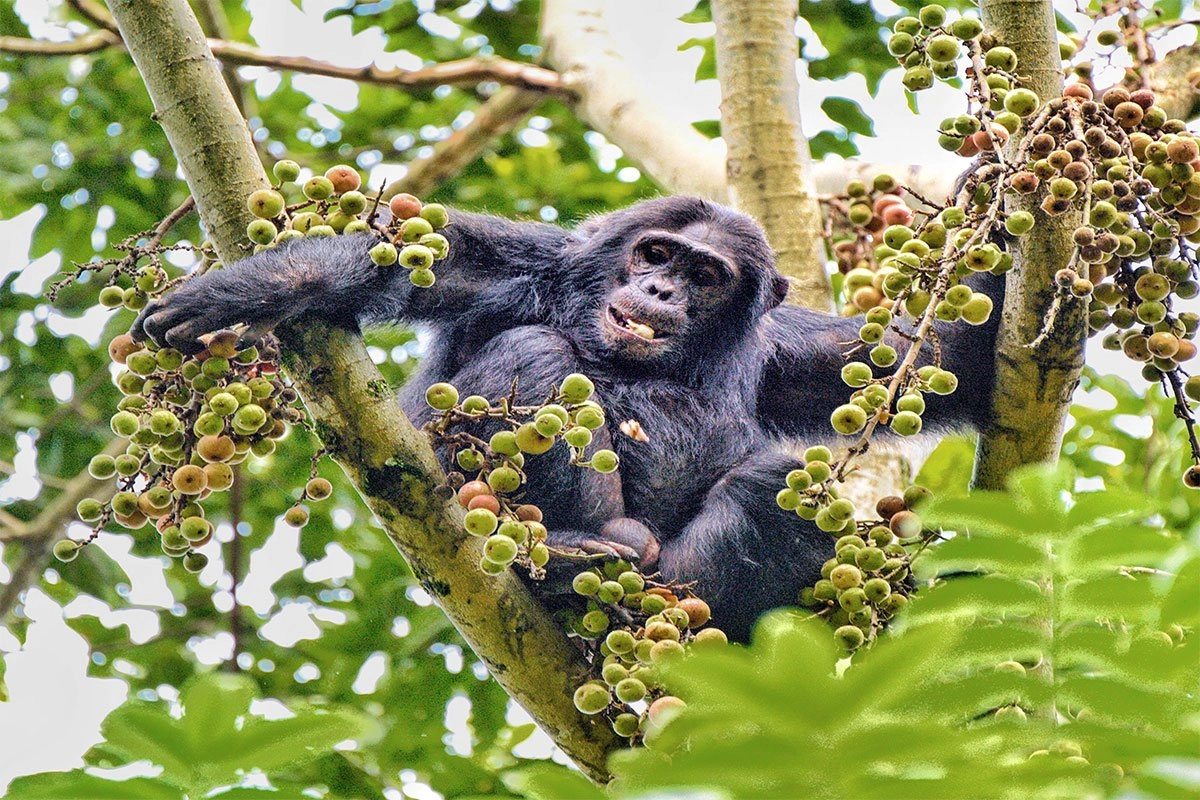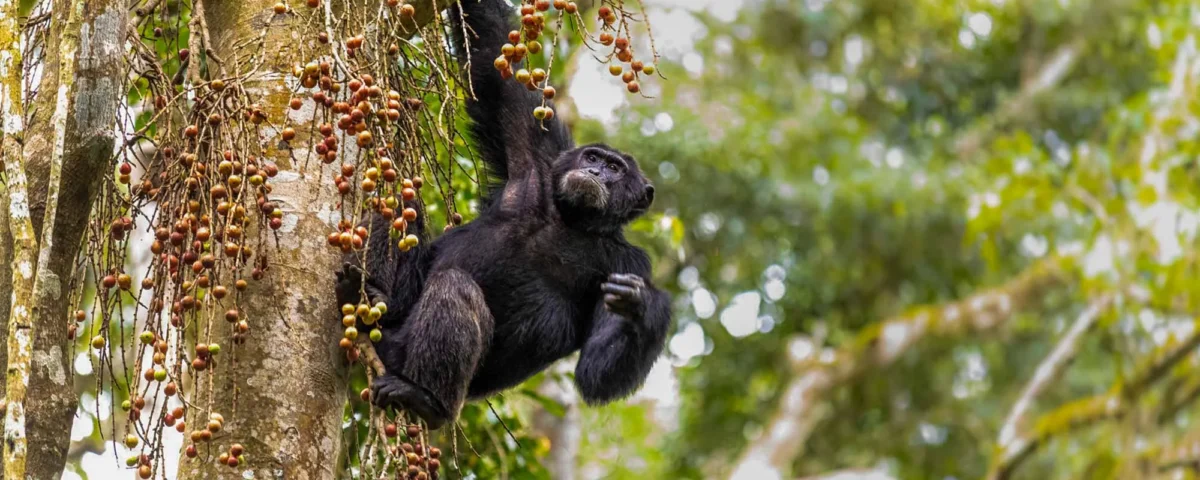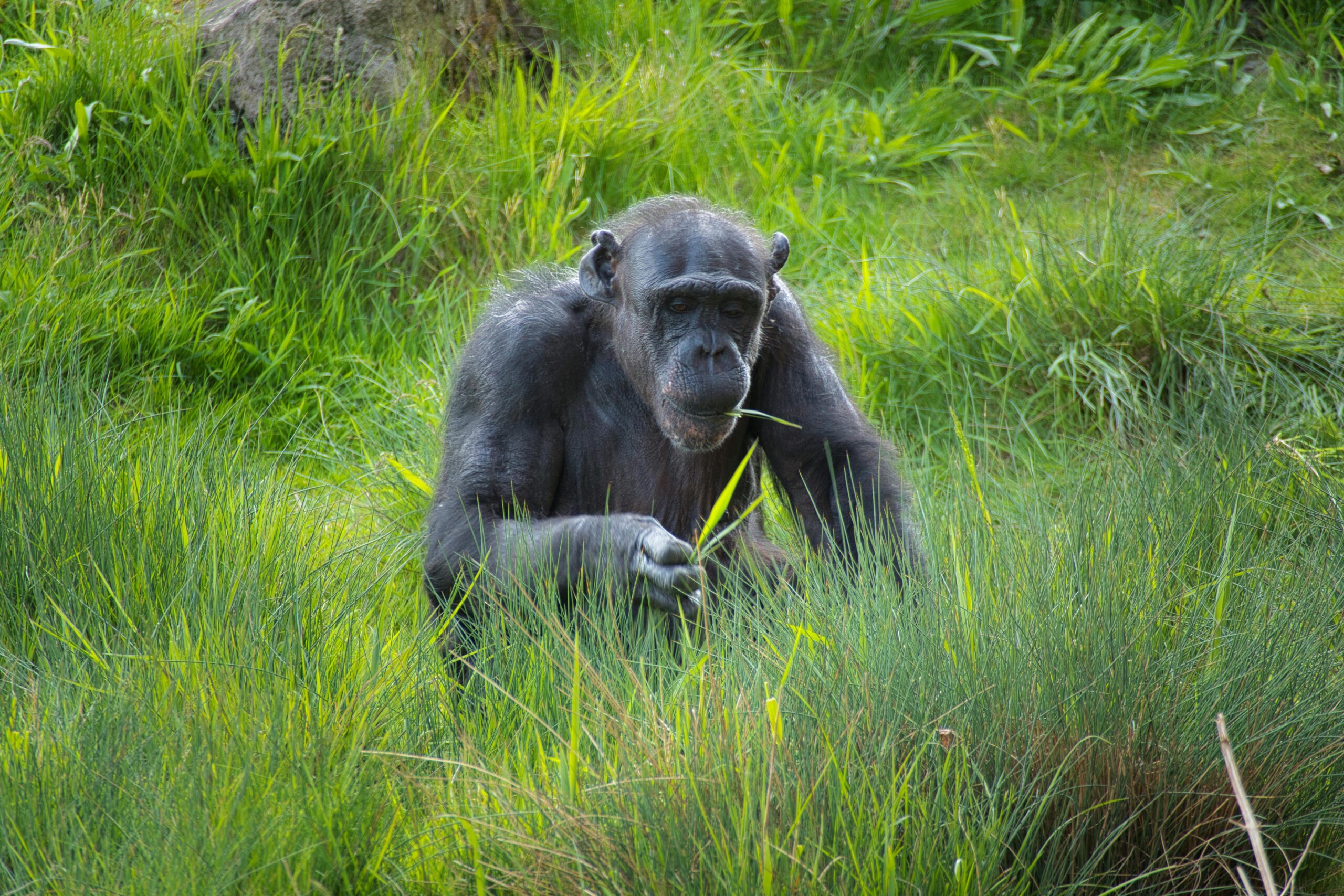
Do Chimpanzees Behave Aggressively When Tracked?
September 27, 2025Do Chimpanzees Move in Groups or Individually During Tracking?
September 27, 2025Do Chimpanzees in Uganda Live in the Wild or Semi-Captive Areas?
Do chimpanzees in Uganda live in the wild or semi-captive areas, and how does this distinction influence your Uganda Safaris experience? Uganda is globally renowned for its biodiversity, offering unparalleled wildlife experiences, particularly through Uganda Chimpanzee Safaris. These primates inhabit both completely wild forests and carefully managed semi-captive environments, providing tourists with different types of encounters depending on conservation status, habitat type, and tourism regulations.
Nkofu Africa Safaris offers tailored itineraries that combine Uganda Wildlife Safaris, Uganda Gorilla Trekking Safaris, Uganda Birding Safaris, and Uganda Cultural Safaris. By understanding whether chimpanzees live in the wild or semi-captive areas, travelers can make informed choices that align with their adventure preferences, physical abilities, and educational interests. Wild chimpanzees reside in protected forest reserves such as Kibale Forest National Park, Budongo Forest Reserve, and Ngogo Forest, where they maintain natural behaviors largely uninfluenced by humans. Semi-captive chimpanzees, on the other hand, are often found in sanctuaries or rehabilitation centers, where they may have been rescued from poaching, deforestation, or the illegal pet trade.
Introduction: Understanding Chimpanzee Habitats in Uganda
Combining wild or semi-captive chimpanzee encounters with Uganda Gorilla Trekking Safaris enhances the depth of your Uganda Best Safaris itinerary, offering opportunities to compare behaviors between species and habitats. Moreover, these experiences often integrate Uganda Cultural Safaris, providing insights into how local communities support conservation and interact sustainably with wildlife. Understanding the distinctions between wild and semi-captive chimpanzees ensures a more meaningful, ethical, and enriching safari experience.
What Defines Wild Chimpanzees in Uganda?
Do chimpanzees in Uganda live in the wild or semi-captive areas, and what characterizes wild populations? Wild chimpanzees live in dense forests and protected reserves, where they forage, socialize, and reproduce independently of direct human management. Locations such as Kibale Forest, Budongo Forest, and Ngogo Forest are prime destinations for Uganda Chimpanzee Safaris, allowing visitors to observe these primates in natural settings.
Wild chimpanzees exhibit complex social structures, including multi-male, multi-female communities with hierarchies, grooming rituals, and cooperative hunting behaviors. Can travelers observe these behaviors closely? Yes, through guided walking safaris and chimpanzee tracking excursions, tourists can witness their daily activities while maintaining safe distances to avoid disturbing natural behavior. These treks are often combined with Uganda Birding Safaris, as forests housing chimpanzees also shelter hundreds of bird species, including endemic and rare birds, creating a comprehensive wildlife adventure.
Wild chimpanzee habitats are critical for ecosystem health, contributing to forest regeneration and biodiversity. Eco-tourism initiatives, such as those organized by Nkofu Africa Safaris, prioritize ethical observation and environmental stewardship. By combining wild chimpanzee encounters with Uganda Gorilla Trekking Safaris, travelers can experience a spectrum of primate behaviors, from forest-dwelling chimpanzees to mountain gorillas, enriching their Uganda Wildlife Safaris itinerary.
What Are Semi-Captive Chimpanzees?
Do chimpanzees in Uganda live in the wild or semi-captive areas, and what defines semi-captive populations? Semi-captive chimpanzees are typically found in rehabilitation centers, sanctuaries, or conservation programs designed to rescue and rehabilitate individuals previously affected by poaching, habitat loss, or illegal pet trade. Unlike their wild counterparts, semi-captive chimpanzees are accustomed to limited human interaction, enabling closer observation and, in some cases, guided educational programs.
Centers such as the Ngamba Island Chimpanzee Sanctuary near Entebbe provide a safe haven for rescued chimpanzees while promoting conservation awareness among visitors. Can these experiences be part of a Uganda Best Safaris itinerary? Absolutely. Semi-captive encounters can be combined with Uganda Gorilla Trekking Safaris or Uganda Cultural Safaris, allowing travelers to gain a broader understanding of conservation challenges, wildlife rescue, and human-wildlife coexistence. Semi-captive chimpanzees often serve as educational ambassadors, helping visitors appreciate the importance of preserving wild habitats and supporting anti-poaching initiatives.
Participation in semi-captive chimpanzee programs also benefits local communities, as conservation centers frequently employ local staff, offer training programs, and contribute to environmental education. Visitors can engage with cultural experiences near these centers, learning about traditional uses of forest resources, sustainable practices, and local conservation initiatives. Combining wild and semi-captive chimpanzee encounters offers a holistic Uganda Chimpanzee Safari experience that blends adventure, education, and responsible tourism.
How Are Experiences Different Between Wild and Semi-Captive Chimpanzees?
Do chimpanzees in Uganda live in the wild or semi-captive areas, and how does this impact the visitor experience? Observing wild chimpanzees provides an authentic glimpse into natural behaviors, from territorial displays to social grooming and foraging strategies. However, sightings are less predictable, requiring patience, fitness, and sometimes long treks through dense forests. Walking safaris led by Nkofu Africa Safaris allow travelers to engage closely with forest ecology, spotting animal tracks, birds, and plants along the way.
In contrast, semi-captive experiences are more structured and accessible. Visitors often have predictable viewing opportunities, educational briefings, and photo-friendly encounters. Can semi-captive experiences replace wild encounters? While semi-captive encounters are valuable for education and rescue awareness, they cannot fully replicate the spontaneity, ecological richness, or behavioral authenticity of wild chimpanzee interactions.
Both types of experiences can be combined with Uganda Gorilla Trekking Safaris, Uganda Wildlife Safaris, or Uganda Birding Safaris to create Uganda Best Safaris itineraries. By participating in both wild and semi-captive programs, travelers gain a complete perspective on primate behavior, conservation strategies, and ecological dynamics, making the safari both informative and unforgettable.
Why Conservation Status Matters in Safari Planning
Do chimpanzees in Uganda live in the wild or semi-captive areas, and why is conservation status important for safari travelers? Wild chimpanzees are classified as endangered, facing threats from habitat destruction, human-wildlife conflict, and poaching. Conservation policies strictly regulate wild chimpanzee viewing through permits, visitor limits, and ethical guidelines to ensure minimal impact on their natural behavior.
Semi-captive chimpanzees, while not free-ranging, play a vital role in conservation education, rehabilitation, and public engagement. Visiting these centers allows travelers to contribute directly to funding anti-poaching initiatives, forest restoration, and local community development programs. Can conservation-focused tours be integrated with Uganda Gorilla Trekking Safaris? Yes. Combining gorilla trekking with chimpanzee experiences ensures travelers support multiple conservation efforts while enjoying diverse wildlife encounters.
Nkofu Africa Safaris emphasizes responsible tourism practices, ensuring that both wild and semi-captive chimpanzee experiences are conducted ethically. Travelers learn not only about primate behavior but also about the broader conservation context, including the challenges of maintaining Uganda’s forests, protecting biodiversity, and supporting local livelihoods. This knowledge enhances the value of Uganda Chimpanzee Safaris and reinforces their role in global conservation awareness.
 How Do Walking Safaris Enhance Chimpanzee Experiences?
How Do Walking Safaris Enhance Chimpanzee Experiences?
Do chimpanzees in Uganda live in the wild or semi-captive areas, and can walking safaris enrich the experience? Walking safaris provide an unparalleled level of immersion for observing wild chimpanzees. Participants move quietly through forest trails with expert guides, noticing subtle signs such as nests, feeding remains, vocalizations, and tracks that would be missed from a vehicle.
Walking safaris can also be combined with Uganda Birding Safaris, as many primate habitats overlap with critical bird areas. Travelers may spot rare species while tracking chimpanzees in Kibale Forest or Budongo Reserve. Can walking safaris be combined with Uganda Gorilla Trekking Safaris? Absolutely — these treks can be part of an integrated itinerary that spans multiple primate species, offering a comprehensive wildlife adventure.
Moreover, walking safaris provide cultural touchpoints, as guides often share insights about local communities, forest resource use, and conservation practices. This combination of ecological observation and cultural understanding makes walking safaris a key component of Uganda Best Safaris, appealing to travelers seeking educational, immersive, and ethically responsible wildlife experiences.
Conclusion: Choosing the Right Chimpanzee Experience
So, do chimpanzees in Uganda live in the wild or semi-captive areas, and how should travelers plan their Uganda Safaris? Wild chimpanzees offer authentic behavioral observations, while semi-captive chimpanzees provide structured educational experiences. Both are valuable for understanding primate behavior, supporting conservation, and engaging in responsible tourism.
By combining wild and semi-captive chimpanzee encounters with Uganda Gorilla Trekking Safaris, Uganda Birding Safaris, and Uganda Cultural Safaris, travelers can craft Uganda Best Safaris itineraries that maximize wildlife encounters, educational value, and cultural immersion. Nkofu Africa Safaris ensures that every experience is ethical, safe, and guided by expert knowledge, reinforcing Uganda’s status as a premier destination for primate tourism.
Whether trekking through forests to observe wild chimpanzees or visiting semi-captive sanctuaries to support conservation efforts, travelers gain insights into Uganda’s unique biodiversity, the challenges of wildlife protection, and the importance of sustainable tourism. Understanding the distinction between wild and semi-captive chimpanzees enhances the safari experience, making it more meaningful, engaging, and memorable.


